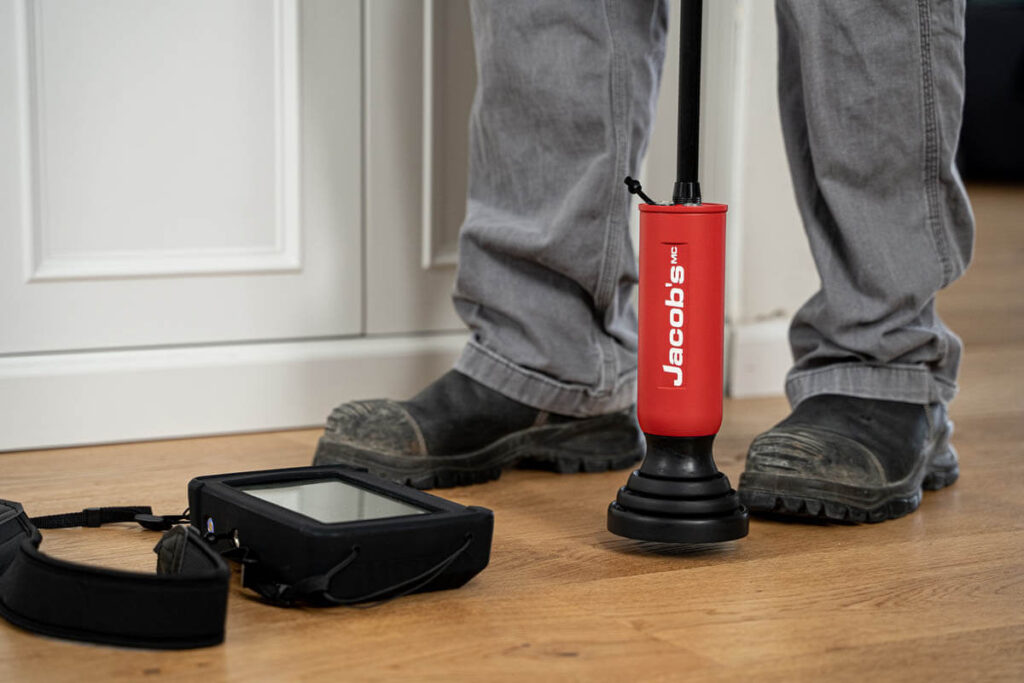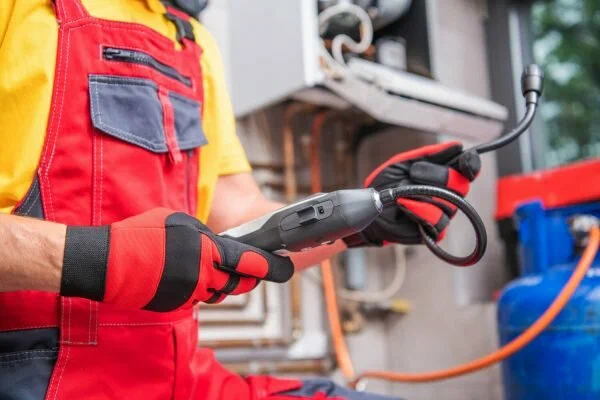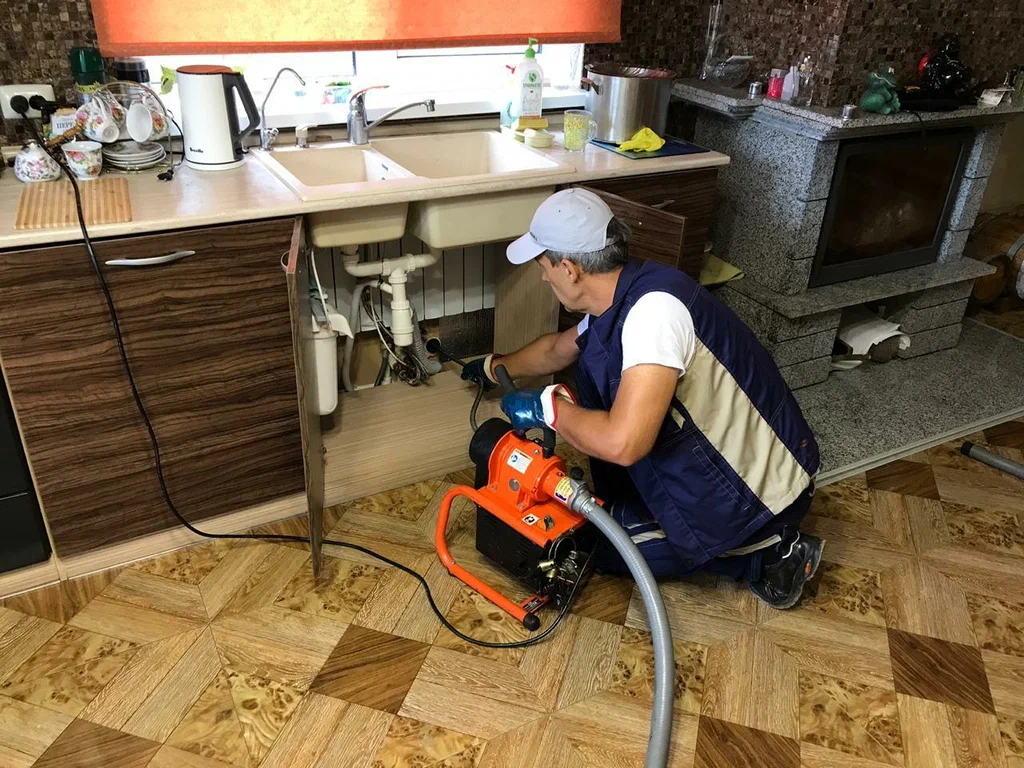Imagine this: you notice your water bill has jumped, but there’s no visible puddle, no dripping faucet, no clue where the leak is hiding. You call a plumber, and they start poking holes in your walls or tearing up your floor — only to discover the leak was in a completely different spot. Not only is this frustrating, but it can also cost you thousands in unnecessary repairs.
That’s why accuracy matters when it comes to acoustical leak detection. The right method can mean the difference between a quick fix and a costly, drawn-out headache.
Two common methods for locating leaks are dye tests and tracer gas testing. While dye tests have been around for decades, technology has moved forward — and tracer gas testing is quickly becoming the gold standard for accuracy and efficiency.
We’ve seen firsthand how much time and money homeowners can save with the right approach. Whether you’re in Henderson, Summerlin, North Las Vegas, or Paradise, we make sure leaks are found without the guesswork.
📞 If you want answers now, call (702) 745-5571 and speak with a certified leak inspection specialist today.
Table of Contents
- Understanding Tracer Gas Testing
- How Dye Tests Work – and Their Limitations
- Tracer Gas Testing vs Dye Tests – A Direct Comparison
- Why Accuracy Matters – The Cost of a Misdiagnosed Leak
- The Technology Behind Advanced Leak Testing
- Benefits of Tracer Gas Testing for Homeowners
- Real-World Example: How Leak Experts USA Solved a Hidden Leak
- When to Choose Tracer Gas Testing Over Dye Tests
- Cost Considerations and Value for Money
- FAQs about Tracer Gas Testing
Understanding Tracer Gas Testing
Tracer gas testing is a highly accurate inspection method that uses a safe, non-toxic gas — usually leak detection with helium or hydrogen — to pinpoint the exact location of leaks in plumbing systems, heating systems, or even underground pipelines.
Here’s how it works:
- The plumbing system is drained or isolated.
- A small, carefully measured amount of tracer gas is introduced into the pipe.
- Using sensitive detectors, technicians monitor where the gas escapes — this is the leak’s exact location.
One of the most advanced versions of this is helium detection, which can find leaks so small they might be completely invisible to the naked eye. Helium is ideal because it’s a very light gas, allowing it to travel quickly through even the tiniest openings.
Unlike visual inspection methods, tracer gas doesn’t rely on staining, color change, or human guesswork. It’s all about pinpoint accuracy, which makes it perfect for leaks hidden behind walls, under concrete, or in underground lines.
Why homeowners love it:
- No unnecessary wall demolition.
- Fast results, often in under an hour.
- Safe for drinking water systems.

How Dye Tests Work – and Their Limitations
Dye testing has been a go-to method for detecting certain leaks, particularly in pools and toilets. The process is simple:
- Colored dye (usually red or blue) is added to the suspected leak area.
- The technician waits to see if the color appears in a different area — indicating the leak’s path.
While dye tests can be useful in some scenarios, they have major limitations when compared to tracer gas:
- Slower detection: You have to wait for the dye to visibly move.
- Messy results: The dye can stain surfaces or require clean-up.
- Limited reach: Dye only works if water is actively moving through the leak path.
- No precision: It might show the general leak area but not the exact point.
For example, if you have a slab leak under your kitchen floor, a dye test might indicate water loss, but it won’t tell you which exact tile to lift. In contrast, tracer gas can pinpoint the leak to a single square foot.
Tracer Gas Testing vs Dye Tests – A Direct Comparison
When it comes to speed, accuracy, and long-term value, tracer gas testing consistently outperforms dye tests.
| Feature | Tracer Gas Testing | Dye Tests |
| Detection Speed | Minutes | Hours or more |
| Accuracy | Pinpoint accuracy (within inches) | General area only |
| Hidden Leaks | Detectable | Often missed |
| Mess or Staining | None | Possible staining |
| Environmental Safety | 100% safe | Safe, but can leave residue |
| Best For | Pipes, slabs, underground leaks | Pools, toilets, simple leaks |
With tracer gas, you’re not relying on gravity or flow to move the dye — the gas moves independently and escapes at the exact leak point, making it ideal for advanced leak testing in complex plumbing systems.
Why Accuracy Matters – The Cost of a Misdiagnosed Leak
Finding a leak isn’t just about spotting water — it’s about knowing exactly where the problem lies. Inaccurate detection can lead to:
- Unnecessary demolition: Knocking down walls or pulling up flooring in the wrong area.
- Wasted labor costs: Multiple visits from plumbers without solving the problem.
- Ongoing water damage: If the leak isn’t fixed quickly, mold and structural damage can develop.
For example, we’ve seen cases where a homeowner thought the leak was near the bathroom because of damp floor tiles. A traditional dye test suggested the same — but when we used tracer gas testing, the real problem turned out to be a small crack in a pipe under the laundry room. That’s nearly 15 feet away from where the dye indicated the issue.
This is where advanced leak testing truly shines. By using scientific methods instead of guesswork, you save money, protect your property, and get the repair right the first time.
The Technology Behind Advanced Leak Testing
Our approach to advanced leak testing combines the latest tools with highly trained technicians.
The Process:
- System Isolation – We isolate the section of plumbing suspected to have a leak.
- Tracer Gas Injection – A mix of hydrogen or helium is introduced into the pipes.
- Sensitive Detection – Our equipment, designed for helium detection, measures even the smallest concentrations of gas escaping from the pipe.
- Pinpoint Accuracy – The detectors identify the precise spot where the gas is escaping — whether it’s behind a wall, beneath concrete, or buried underground.
Why helium?
- It’s lighter than air, so it rises and escapes quickly from leaks.
- It’s inert and completely safe for humans, pets, and drinking water systems.
- Its molecules are small enough to pass through the tiniest cracks — which means pinpoint accuracy is possible even for microscopic leaks.
This combination of modern gas detection tools and expert interpretation ensures that no leak goes unnoticed.
Benefits of Tracer Gas Testing for Homeowners
When you choose tracer gas testing over dye tests, you’re investing in more than just finding a leak — you’re investing in your home’s long-term health.
Here’s why homeowners trust it:
✅ Pinpoint accuracy means minimal damage — no tearing apart entire walls to find a single crack.
✅ Works on all types of plumbing, including copper, PEX, and PVC.
✅ Effective for hidden and underground leaks that other methods might miss.
✅ No staining, contamination, or mess to clean up afterward.
✅ Safe for all water systems, including drinking water lines.
✅ Backed by our years of hands-on experience.

We’ve performed tracer gas leak testing and detection services Las Vegas for countless properties — from single-family homes to luxury estates — and in almost every case, the homeowners were relieved that the leak could be located without expensive, invasive destruction.
Real-World Example: How Leak Experts USA Solved a Hidden Leak
A homeowner in Henderson contacted us after noticing a musty smell in their living room. They had already tried a dye test with another company, which suggested a leak somewhere near the guest bathroom. The contractor began removing floor tiles but found nothing — and the leak persisted.
We decided to use tracer gas testing right away. Here’s what happened:
- We isolated the home’s main water line feeding the affected area.
- We introduced a safe hydrogen gas mix into the system.
- Using our helium detection equipment, we scanned the home.
- Within 25 minutes, we found the leak — in a copper pipe joint hidden inside a wall on the opposite side of the living room.
Because of the pinpoint accuracy of the tracer gas method, the repair involved opening just a 12-inch square of drywall. The homeowner avoided removing additional flooring or breaking through concrete — saving thousands in restoration costs.

When to Choose Tracer Gas Testing Over Dye Tests
While dye tests have their place (such as basic pool leak checks or toilet tank leaks), there are clear situations where tracer gas testing is the better choice:
✅ Multiple possible leak locations – When the source is unclear and you need a definitive answer.
✅ Hidden leaks behind walls or under concrete – Gas travels easily and escapes exactly where the leak is, allowing for advanced leak testing without destruction.
✅ High-value or historic properties – Minimal disruption is essential to protect finishes and structures.
✅ Leaks in pressurized systems – Dye needs water flow; tracer gas works even without water moving through the system.
On the other hand, if you have a straightforward leak with visible access — like a faulty toilet flapper or a pool skimmer leak — a dye test might be faster and cheaper. But for accuracy and versatility, tracer gas remains the clear winner.
Cost Considerations and Value for Money
Some homeowners hesitate when they hear that tracer gas testing may cost slightly more than dye testing upfront. But when you factor in the total repair cost, tracer gas almost always saves money in the long run.
Here’s why:
- Fewer unnecessary repairs – No guessing means you only fix what’s broken.
- Less demolition – Smaller, targeted openings reduce restoration costs.
- Faster results – Technicians can start repairs immediately after detection.
- Prevention of further damage – Finding and fixing leaks quickly avoids costly water damage and mold remediation.
We’ve had clients tell us that the additional $100–$200 for tracer gas testing saved them thousands in flooring, drywall, and labor.
We keep pricing transparent and fair. Our tracer gas leaks detection Las Vegas service includes both the testing and a detailed explanation of the results — so you know exactly what’s happening and how to fix it.
FAQs about Tracer Gas Testing
Q1: What is tracer gas testing?
Tracer gas testing is a precise inspection method that uses safe, non-toxic gases—commonly helium or hydrogen—to locate leaks in plumbing, pipelines, or sealed systems. It’s highly effective because the gas can seep through even the smallest openings, allowing technicians to pinpoint the exact leak location.
Q2: Is tracer gas testing safe?
Yes. Tracer gases like helium and hydrogen are non-toxic and environmentally friendly when used in proper concentrations. They pose no risk to occupants, making this a safe choice for residential, commercial, and industrial leak detection.
Q3: How accurate is tracer gas testing compared to other methods?
Tracer gas testing offers pinpoint accuracy that surpasses many traditional leak detection methods. Unlike visual inspections or water pressure tests, it can detect extremely small leaks—often before they become major problems.
Q4: How long does the process take?
The duration depends on the system size and complexity. In most cases, leak inspections can be completed within a few hours. Large or intricate systems may require more time to ensure thorough testing.
Q5: Can tracer gas testing be used for swimming pools and spas?
Absolutely. Tracer gas testing is ideal for locating hard-to-find leaks in swimming pools, spas, and other water features without unnecessary digging or costly guesswork.
Q6: How much does tracer gas testing cost in Las Vegas?
Costs vary depending on the size of the system, the location of the leak, and the complexity of the job. However, it’s often more cost-effective in the long run because it prevents damage and avoids repeated, unsuccessful repair attempts.
Sealing the Deal: Your Next Step to Leak-Free Living
When it comes to leak detection, accuracy matters more than guesswork. Tracer gas testing delivers unmatched precision, allowing you to detect and repair leaks before they escalate into expensive, time-consuming issues. Whether you’re dealing with a residential plumbing leak, a commercial system, or a tricky pool problem, this advanced leak testing method offers pinpoint accuracy and peace of mind.
If you’re in Las Vegas and want a solution that saves you time, money, and unnecessary hassle, don’t settle for outdated Inspection methods. Choose a proven approach that works the first time.
Call us today to schedule your professional tracer gas leak detection in Las Vegas and experience the difference of advanced leak testing done right!
📞 Call us now at (702) 745-5571 Follow us on Instagram for regular updates!

